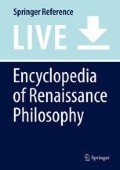Abstract
The formulation of the laws of free fall and projectile motion is usually regarded as Galileo’s most important scientific achievement. The new science of motion was however met with skepticism not only by Aristotelians but also by mechanical philosophers. After the publication of the Dialogo sopra i due massimi sistemi del mondo (1632) and the Discorsi e dimostrazioni matematiche intorno a due nuove scienze (1638), interesting discussions took place in Europe concerning the validity of the law of fall. The issues that were mostly debated were (a) the possibility of deriving that law from a causal explanation of gravity, (b) Galileo’s views concerning the composition of continuous magnitudes, and (c) the alleged lack of empirical support in favor of the law.
References
Primary Literature
Baliani, Giovan Battista. 1998. In De motu naturali gravium solidorum et liquidorum, ed. G. Baroncelli. Florence: Giunti.
Descartes, René. 1964–1974. Oeuvres de Descartes. Eds. C. Adam and P. Tannery (13 vols., Paris, 1897–1913), new edition B. Rochot and P. Costabel, 11 vols. Paris: Vrin.
Fabri, Honoré. 1646. Tractatus physicus de motu locali, in quo effectus omnes, qui ad impetum, motum naturalem, violentum, et mixtum pertinent, explicantur. Auctore P. Mousnerio cuncta excerpta ex praelectionibus R.P. Honorati Fabri. Lyon: Champion.
Galilei, Galileo. 1967. Dialogue concerning the two chief world systems, 2nd ed. Trans. S. Drake. Berkeley: University of California Press.
Galilei, Galileo. 1989. Two new sciences, 2nd ed. Trans. S. Drake. Toronto: Wall & Emerson.
Gassendi, Pierre. 1658. Opera omnia in sex tomos divisa. Lyon: Anisson et Devenet.
Le Cazre, Pierre. 1645. Physica demonstratio qua ratio, mensura, modus, ac potentia, accelerationis motus in naturali descensu gravium determinantur. Adversus nuper excogitatam a Galilaeo Galilaei Florentino Philosopho ac Mathematico de eodem Motu Pseudo-scientiam. Paris: Du Brueil.
Mersenne, Marin. 1633. Traité des mouvemens, et de la cheute des corps pesans et de la proportion de leurs différentes vitesses. Paris: Villery.
Mersenne, Marin. 1647. Novarum observationum physico-mathematicarum … tomus III. Paris: Bertier.
Mersenne, Marin. 1945–1988. Correspondance du P. Marin Mersenne, religieux minime, 17 vols, eds. C. De Waard, M.B. Rochot, R. Pintard and A. Beaulieu. Paris: PUF and CNRS.
Newton, Isaac. 1999. The Principia. Mathematical principles of natural philosophy. Trans. I.B. Cohen and A. Whitman, with a supplement by I.B. Cohen. Berkeley: University of California Press.
Oresme, Nicole. 1968. Nicole Oresme and the Medieval Geometry of qualities and motions: A treatise of the uniformity and difformity of intensities known as Tractatus de configurationibus qualitatum et motuum. Trans. M. Clagett. Madison/ Milwaukee/London: University of Wisconsin Press.
Secondary Literature
Arthur, Richard. 2016. On the mathematization of free fall: Galileo, descartes, and a history of Misconstrual. In The language of nature: Reassessing the mathematization of natural philosophy in the seventeenth century, ed. G. Gorham, B. Hill, E. Slowik, and C.K. Waters, 81–101. Minneapolis: University of Minnesota Press.
Blay, Michel. 1998. Reasoning with the infinite. From the closed world to the mathematical universe. Trans. M.B. De Bevoise, Chicago : University of Chicago Press.
Blay, Michel, and Egidio Festa. 1998. Mouvement, continu et composition des vitesses au XVIIe siècle. Archives Internationales d’Histoire des Sciences 48: 65–118.
Damerow, Peter, Gideon Freudenthal, Peter McLaughlin, and Jürgen Renn. 2004. Exploring the limits of preclassical mechanics. 2nd ed. New York/Berlin/Heidelberg: Springer.
Dear, Peter. 1984. Mersenne and the learning of the schools. Ithaca: Cornell University Press.
Dear, Peter. 1995. Discipline & experience: The mathematical way in the scientific revolution. Chicago: University of Chicago Press.
Drake, Stillman. 1974. Galileo’s work on free fall in 1604. Physis 16: 309–322.
Elazar, Michael. 2011. Honoré Fabri and the concept of impetus: A bridge between conceptual frameworks. Dordrecht/Heidelberg/London/New York: Springer.
Galluzzi, Paolo. 1979. Momento. Studi Galileiani. Rome: Edizioni dell’Ateneo e Bizzarri.
Galluzzi, Paolo. 2000. Gassendi and l’Affaire Galilée of the laws of motion. Science in Context 13: 509–545.
Giusti, Enrico. 1990. Galileo e le leggi del moto. In Galileo Galilei, Discorsi e dimostrazioni matematiche intorno a due nuove scienze, ix–lx, ed. E. Giusti. Turin: Einaudi.
Jullien, Vincent, and André Charrak. 2002. Ce que dit Descartes touchant la chute des graves: de 1618 à 1646, étude d’un indicateur de la philosophie naturelle cartésienne. Paris: Presses Universitaires du Septentrion.
Mahoney, Michael S. 1985. Diagrams and Dynamics: Mathematical Reflections on Edgerton’s Thesis. In Science and the Arts in the Renaissance, ed. John W. Shirley and F. David Hoeniger, 198-220. Washington: Folger Shakespeare Library.
Maier, Anneliese. 1949. Die Vorläufer Galileis im 14. Jahrhundert. Studien Zur Naturphilosophie der Spätscholastik. Rome: Edizioni di Storia e Letteratura.
Palmerino, Carla Rita. 1999. Infinite degrees of speed. Marin Mersenne and the debate over Galileo’s law of free fall. Early Science and Medicine 4: 269–328.
Palmerino, Carla Rita. 2003. Two Aristotelian responses to Galilei’s science of motion: Honoré Fabri and Pierre Le Cazre. In The new science and Jesuit science, ed. M. Feingold, 187–227. Dodrecht/Boston: Springer.
Palmerino, Carla Rita. 2004. Galileo’s theories of free fall and projectile motion as interpreted by Pierre Gassendi. In The reception of the Galilean science of motion in seventeenth-century Europe, ed. C.R. Palmerino and J.M.M.H. Thijssen, 137–164. Dordrecht: Kluwer.
Palmerino, Carla Rita. 2010a. Experiments, mathematics, physical causes: How Mersenne came to doubt the validity of Galileo's law of free fall. Perspectives on Science 18: 50–76.
Palmerino, Carla Rita. 2010b. The Geometrization of motion: Galileo’s triangle of speed and its various transformations. Early Science and Medicine 15: 410–447.
Sylla, Edith. 1986. Galileo and the Oxford Calculatores: Analytical languages and the mean-speed theorem for accelerated motion. In Reinterpreting Galileo, ed. William A. Wallace, 53–108. Washington, DC: The Catholic University Press of America.
Author information
Authors and Affiliations
Corresponding author
Editor information
Editors and Affiliations
Section Editor information
Rights and permissions
Copyright information
© 2019 Springer Nature Switzerland AG
About this entry
Cite this entry
Palmerino, C.R. (2019). Law of Free Fall in Renaissance Science. In: Sgarbi, M. (eds) Encyclopedia of Renaissance Philosophy. Springer, Cham. https://doi.org/10.1007/978-3-319-02848-4_939-1
Download citation
DOI: https://doi.org/10.1007/978-3-319-02848-4_939-1
Received:
Accepted:
Published:
Publisher Name: Springer, Cham
Print ISBN: 978-3-319-02848-4
Online ISBN: 978-3-319-02848-4
eBook Packages: Springer Reference Religion and PhilosophyReference Module Humanities and Social SciencesReference Module Humanities

